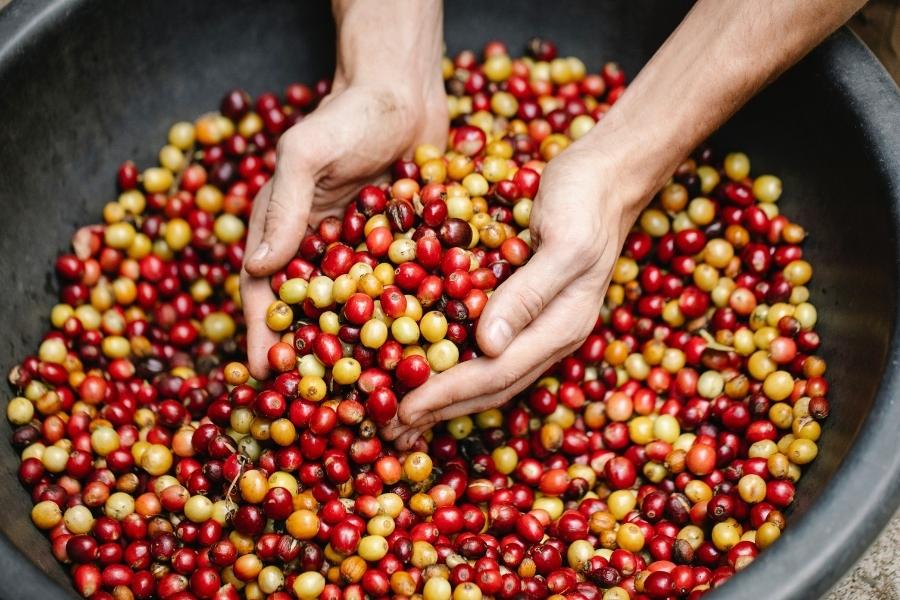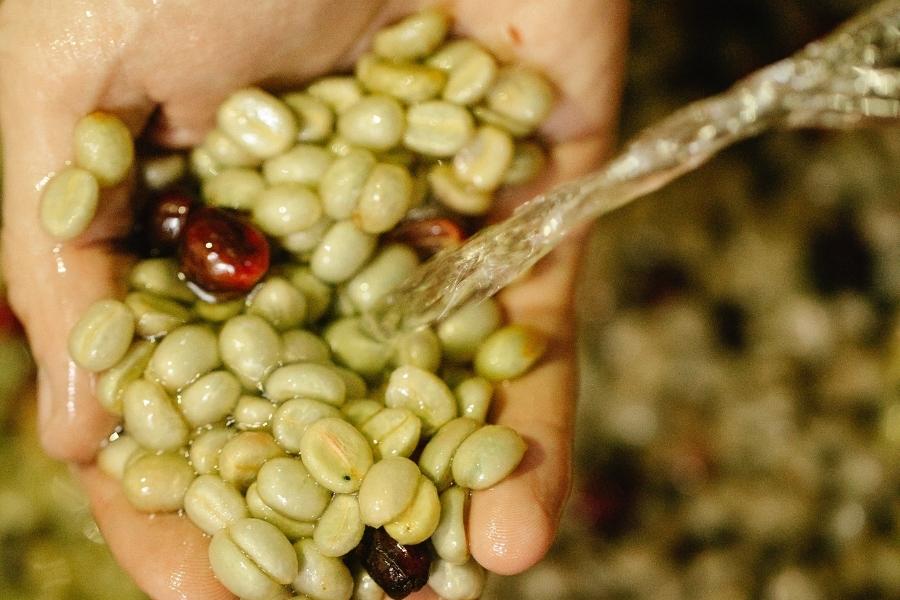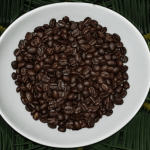There are two main ways to process coffee beans: washed and unwashed. I will discuss the differences between washed vs unwashed coffee and help you decide which processing method is right for you.
Contents
Washed vs Unwashed Coffee General Overview
These are simply beans that have been processed in different ways. Washed beans have had their fruit removed before being dried, while unwashed still have the fruit attached when they are dried. The washing process can have a big impact on the final flavor of java. Washed coffees tend to be brighter and cleaner-tasting, while unwashed can be heavier and more complex.
These days, most of the java you will find on store shelves is washed. The washing process makes it easier to remove impurities from the beans, resulting in a more consistent final product.

Washed Coffee Overview
In this type of coffee, the cherries are first soaked in water to loosen the fruit from the bean and put through a machine that removes the fruit. After the fruit is removed, the beans are washed again and dried in the sun or put in a mechanical dryer. They are usually consistent since all fermentation occurs at the start of the fermentation process, making it easier to regulate its consistency. In terms of taste, several factors affect how the final taste including:
- The roast level: These coffees are typically lighter roasts, while unwashed coffees can be roasted to a darker level affecting the flavors present.
- The origin of the beans: Coffees from different regions can have different flavor profiles, so this is something to keep in mind when trying different types of washed java.
Benefits
- Uniformity of coffee beans: These beans tend to have similar size and shape resulting in a more even roast and flavor.
- Less likely to be stained by the fruit juices on the cherry: This is because the washing process removes most of the fruit juices.
- Contains fewer impurities: The beans have less opportunity to absorb flavors from their environment thus producing a more pure cup of joe.
Drawbacks
- Requires more water: The cherries need to be soaked in water before the fruit is removed, which requires a lot of water.
- Can be more expensive: The washing process is usually done by machines, which can add to the cost of production.
Washed Coffee Processing
This is a somewhat simple processing method that can take anywhere between six hours to four days.
Sorting
First, gather and sort the cherries into ripe and immature cherries in floating water. The ripe ones, which represent good coffee, will drop to the bottom, whereas the unripe ones, which are bad, will float.
Pulping
The next step is to extract the cherry’s pulp or peel. The ripe cherries are tossed into a de-pulping machine, which removes the outer layers and exposes the seeds – or beans.
Fermentation
The seeds are funneled into a big water tank through a tube and any seeds that float to the surface of the water will be removed. For roughly 18-24 hours, the seeds are kept in the water tank. This length might vary based on temperature, nation, and local processes.
Drying
After the seeds have finished fermenting, they are removed from the water tanks and allowed to dry. Seeds are dried in the sun on smaller farms, whereas mechanical dryers are used on bigger farms. A mix of the two is also possible.
Unwashed Coffee Overview
Unwashed is made by leaving the fruit on the bean when it is dried. The cherries are placed on raised beds and left to dry in the sun or mechanical dryers.
Unwashed coffees can have more complex flavors since the fruit is left on the bean during drying. They’re also more likely to have defected since the fruit can attract pests or mold.
Estimating unwashed coffees’ final cup profile is more challenging than washed coffees. This is because the fermentation process continues within the berry during the drying process, which might take a long period.

Benefits
- Good source of antioxidants: These beneficial compounds help protect your body against damage from free radicals, contributing to aging and disease
- Less water required: Since the cherries don’t need to be soaked, less water is required in the production process.
- Less cost incurred during production: Unwashed coffee is a cut above the rest because it can be made more easily without any expensive hardware.
Drawbacks
- Can contain harmful bacteria and mold: In humid and wet conditions, the chances of the beans turning moldy before roasting are high. These contaminants can cause illnesses.
- Uneven drying process: wet processing can be less consistent since the fruit can add unpredictability to the drying process.
Unwashed Coffee Processing
Unwashed or dry processing, unlike the wet processing method, requires leaving the fruit intact and undisturbed. Red cherries are sorted and screened in the same way as white cherries, although they are not washed. Instead of being washed, the cherries are placed directly into flotation tanks, where any surplus dirt is separated.
The cherries are then cleaned and dried in the sun where they’re laid out in a single layer and stirred every hour or so. Workers pluck out any damaged cherries at this point. Depending on the weather, the entire drying process might take anywhere from two to three weeks.
In terms of hardware, it is more accessible and less expensive to make, yet it may command a premium price. There is always a risk of losing the harvest in rainy weather. However, because it grows in some of the driest microclimates, that hazard is much reduced.
Comparing Washed and Unwashed Coffee
The processing of the cherries mainly determines their characteristics. You can tell if your coffee is wet-processed or unwashed by its appearance, taste, and acidity.
Similarities Between Washed and Unwashed Coffee
- They are both roasted to bring out the bean’s flavor. The roasting process is where the bean is heated to produce flavor.
- Both types go through a sorting process. This is to remove any defects in the beans.
- Washed and unwashed are both dried after processing. Drying beans helps to preserve them and maintain their flavor.
- Both need to be ground before processing. This is to ensure that all the flavors are extracted from the bean.
Differences Between Washed and Unwashed Coffee
Coffee beans are processed in the drying and the wet process. During the drying process, the beans are dried in the sun before hulling to remove the dried husk which is surrounding the bean. In the wet process, beans are soaked in water before being hulled.
The dry process results in a cup of java with more body and less acidity. The wet process results in java with more acidity and less body. Here are other differences between washed and unwashed coffee.
Roasting Duration
Washed is roasted for a shorter period. This is done to preserve the delicate flavors of the bean. Unwashed is roasted for a longer period, giving it a more robust flavor.
Availability
The former is typically more available. This is because they are produced in larger quantities. Unwashed coffees are rare and less available since this is a relatively older method for processing coffee.
Popularity
Washed coffees tend to be more popular. This is because they have a cleaner flavor and are more widely available.
Oil Content
The higher oil content in unwashed beans can make them more resistant to spoiling, meaning they’ll stay fresher for longer.
Acidity Levels
Washed coffees have a higher acidity. This is because the beans are cleaned in water, which removes some of the natural acids. Unwashed coffees have a lower acidity since they are not washed.
Flavor
Washed coffees tend to have a more complex flavor. This is because the washing process removes some of the natural oils and flavors from the bean. Unwashed coffees have a simpler flavor since they retain more of their natural oils and flavors.
Taste
Washed coffees are typically cleaner in taste. This is because the washing process removes impurities and flavors that can be harsh or unpleasant. Unwashed coffees can have more impurities and flavors, which may be perceived as being less clean in taste.
Washed java is lighter in the body. This means it has less of a mouthfeel and is less filling. Unwashed is fuller-bodied, which can make it more filling.

The Major Distinguishing Factor Between Washed and Unwashed Coffee
The major distinguishing factor between the two is the presence or absence of mucilage. Washed refers to coffee that has been rinsed with water to remove mucilage, while unwashed has not been rinsed and still retains the mucilage on the beans.
Mucilage is a sticky substance produced by the plant and coats the beans. It is composed of sugars, proteins, and other compounds that give it a gel-like consistency.
The mucilage layer is removed from beans during the washing process. This can be done either mechanically or using a water soak. The beans are then dried and hulled to remove the outer layer of the coffee cherry.
When to Drink Washed Coffee
It is best drunk as soon as possible after buying it. Its clean, bright flavors are at their height within a few months of roasting and will gradually become muted. If you’re fortunate enough to have access to freshly roasted washed coffee, consume it as quickly as possible.
If your java is tasting flat or dull, that’s a sign that it’s past its prime, and you should consider buying fresher beans. Generally, lighter roasts are more delicate and have shorter shelf lives than dark roasts.
The longer roast time breaks down more of the complex molecules that give washed coffee its flavor.
When to Drink Unwashed Coffee
If you enjoy a more intense flavor, then this is probably for you. The longer the beans are left in contact with the fruit, the more intense the flavors will be. If you’re looking for a fruity and complex cup of joe, go for this type of java.
Some people also find that it has a more syrupy body than washed coffees. This is because the beans still have some fruit pulp on them, which can add sweetness and body to the cup.
Which Coffee Is Better?
Washed coffee has a cleaner taste because the cherries are processed with water to remove any impurities before they are dried. Unwashed has a more complex flavor because the beans are not cleaned before drying.
So, which type is better? If you like a cleaner tasting coffee, you should go for washed. If you prefer a more complex flavor, then unwashed coffee is the way to go.
Final Thoughts
Washed coffee has a cleaner taste and brighter acidity while unwashed coffee is earthier and has more body. While there are pros and cons to both washed vs unwashed coffee, it ultimately comes down to personal preference.

